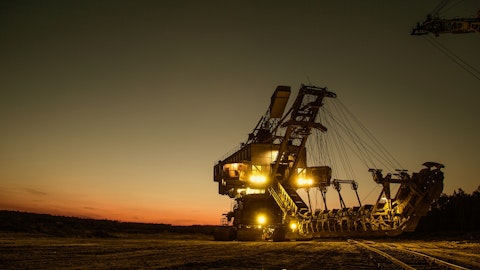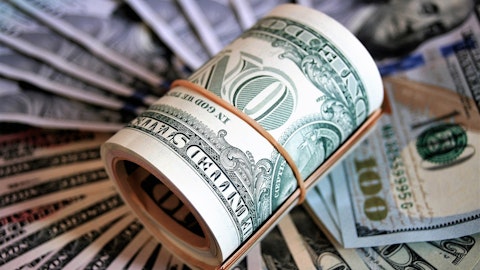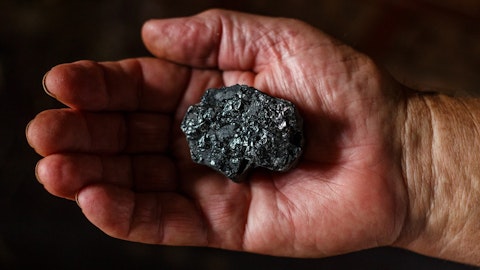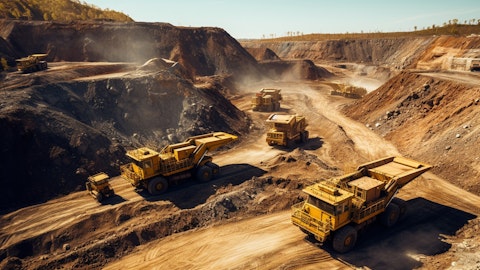Vale S.A. (NYSE:VALE) Q3 2023 Earnings Call Transcript October 27, 2023
Operator: Good morning, ladies and gentlemen. Welcome to Vale’s conference call to discuss the third quarter results of 2023. [Operator Instructions]. As a reminder, this conference is being recorded, and the recording will be available on the company’s website at vale.com in the area for investors. The slide presentation that accompanies this call is being broadcast on the Internet and is also available in the investor’s area of the company’s website. There is a slight two second delay between the audio and slide changes compared to the audio transmitted via phone. Before proceeding, let me mention that forward-looking statements may be provided in this presentation, including Vale’s expectations about future events or results encompassing those matters listed in the respective presentation.
We caution you that forward-looking statements are not guarantees of future performance and involve risks and uncertainties. To obtain information on factors that may lead to results different from those forecast by Vale, please consult the report Vale filed with the U.S. Securities and Exchange Commission, SEC, the Brazilian Comissao de Valores Mobiliarios CVM, and in particular, the factors discussed under forward-looking statements and Risk Factors in Vale’s annual report on Form 20-F. With us today are Mr. Eduardo De Salles Bartolomeo, Chief Executive Officer; Mr. Gustavo Pimenta, Executive Vice President of Finance and Investor Relations, Mr. Marcello Spinelli, Executive Vice President, Iron Ore Solutions; Mrs. Deshnee Naidoo, CEO Vale Base Metals; Mr. Carlos Medeiros, Executive Vice President of Operations.
Mr. Eduardo Bartolomeo will begin his presentation on Vale’s third quarter performance and after that, he will be available for questions-and-answers. It is now my pleasure to turn the call over to Mr. Eduardo Bartolomeo. Sir, you may now begin.
Eduardo de Salles Bartolomeo: Thank you. Good morning, everyone. I hope you are all doing well. We continue to make significant progress on our strategic business priorities. We delivered a solid production performance this quarter and throughout 2023. In IRR Solutions, we delivered substantial output with increased average quality while also lowering our production to sales gap as expected. In Energy Transition Metals, Salobo III is successfully humping up contributing to our copper growth year-to-date with total production 10% higher in the quarter in supporting lower unit costs. In nickel, we remain on track to deliver our production guidance while reviewing our assets to unlock value potential. On our path to decarbonization, we are accelerating breakthrough iron ore solutions.
We are commissioning our first briquetting plant in Tubarao and signed 2 strategic agreements to assess the development of Mega Hubs. We are advancing in circular mining initiatives. We created a data to develop our sustainable sand operations, and we signed an agreement with BluestOne to foster waste-to-value transformation solutions in base metals. On then safety, we continue to deliver on a new framework towards a safer value. We completed the decharacterization of our 13th upstream dam and reduced the emergency level of B3/B4 dam to the lowest. On top of that, we remain with our disciplined capital allocation approach. We just approved a $2 billion shareholder remuneration payment for December. With that, total dividends and interest on capital distributed since 2021 represents a 29% yield for our shareholders.
We also launched our fourth share buyback program. Since 2021, Vale has repurchased over 16% of its share base concentrating shareholders’ future earnings by about 20%. As you can see, we are delivering on our commitments and reaping good results from our structural change. Let me go into more detail about our performance. Next slide, please. We had strong results this quarter, and we are starting Q4 at a robust pace, well positioned to deliver on our guidance. In Iron Ore Solutions, we continue to operate S11D at a high rate while increasing pellet feed production from Brucutu, thanks to the Torto dam commissioning. We delivered 5 million tonnes above the 9 months output in 2022. We also improved our portfolio average quality and boosted pellet production by 11% this quarter.
We faced one-off engineering issues at S11D and the effects of a power outage across Brazil. And despite those issues, we are on our way to deliver a solid Q4 output. Iron Ore finds and pellet sales increased by 6% this quarter, reducing our accumulated production to sales gap. Usually, in the third quarter, we had a high production to sales gap, but this quarter, we shortened that gap by around 50% compared to last year. In Q4, we expect to reduce this gap even further. In Energy Transition Metals, copper production grew 10% in the quarter and 22% on a 9-month basis as an increase of 41 kilotonnes compared to last year. Thanks to the successful ramp-up of Salobo III, which is now operating at 80% of its capacity. In September, the Salobo complex reached its highest monthly production levels since 2019.
Copper sales were exceptional for the period growing about 5% quarter-on-quarter and 22% on a 9-month basis. Even though we have been delivering a substantial output, we have decided to lower our production guidance by around 15 kilotonnes given some change to the North Atlantic mining method and additional maintenance. In nickel, we are performing as planned, which includes the continued transition of the Voisey’s Bay mine to underground and the rebuild of the Onca Puma furnace #1 later this year. Our outlook for 2022 nickel production remains unchanged. Next slide, please. We are accelerating breakthrough Iron Ore solutions to deliver the high-quality required by a decarbonizing world. The first brick cutting plant is under commissioning with the ramp-up expected by the end of this year.
We expect to commission the second plant in early 2024 with the ramp-up at the beginning of the second quarter. The combined capacity will be 6 million tonnes per year. 2024 will be our first year with industrial level production and will be a near of operational fine-tuning for the long-term reliability. On the Mega Hubs development front, we signed 2 strategic agreements to assess opportunities with Porto do Acu for a facility in Brazil for hot rigid iron production using our pellets and with H2 Green Steel for concentration units in Brazil and the United States, directed towards products for the low carbon steel value chain, including HPI using our briquettes. Concentration solutions are critical to our de-carbonization strategy, and we expect to build our first mega hub in 2024.
Next slide, please. Fostering circular mining, we launched at Agera, a company dedicated to developing our sustainable sand business. Agera trades and distribute sand extracting from the tailing dams of our iron ore operations. This type of operation allow us to reduce the use of dams and [indiscernible] in our iron ore operation, and we hope to scale up this business. In addition, value-based metals signed a long-term agreement with BluestOne to reuse tailings to produce fertilizers. Onca Puma Mine, we will supply BluestOne with slag for the next 10 years. This initiative expands circular mining within our Energy Transition Metals business. Furthermore, we signed 2 other strategic partnerships to assess decarbonization opportunities. With H2 Green Steel, Vale is taking its first step into the green hydrogen market.
H2 Green Steel’s expertise will be critical for developing green hydrogen in the Mega Hubs in Brazil and the United States. With Petrobras, we will assess the acceleration of low-carbon solutions taking advantage of the joint technical expertise and synergies of our 2 companies. Vale plays a leading role in the decarbonization journey by leveraging relevant actions to enable the energy transition. These agreements fit perfectly into this context. Next slide, please. Finally, we are building a safer Vale. We’ve completed the decharacterization of the 13th upstream dam. We are progressing on our upstream dam decharacterization program with the highest safe standards in place. In addition, after removing around 85% of tailings from B3/B4 dam, we reduced this emergence level to the lowest possible with decharacterization to be completed in 2025.
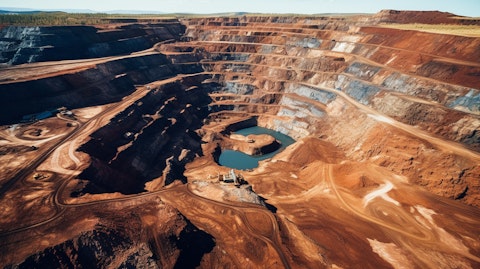
Since 2020, we have implemented several safety measures upgrading over 40% of our structures at emergency levels to a safe status. We continue to systematically reduce the risk and to implement the best international practice in the management, while simultaneously developing solutions to minimize them usage. Now for our financial results, I’ll pass the floor to Gustavo. Thank you.
Gustavo Pimenta: Thanks, Eduardo, and good morning, everyone. Let me start with our EBITDA performance for the quarter. As you can see, we delivered an EBITDA of $4.5 billion in Q3, almost $0.5 billion higher than the same period last year. The increase is explained by higher realized prices, which increased 13% year-on-year for iron ore and 16% for copper. On volumes, iron ore findings and pellet sales increased 4.4 million tonnes year-on-year, taking advantage of favorable market conditions while reducing the usual production to sales gap in Q3. The impact of cost and expenses on EBITDA was $189 million year-on-year, partially explained by the $56 million effect from the consumption of iron ore inventories from the previous quarter at higher costs as well as higher maintenance carried out in our nickel businesses.
I will go into more detail on costs later in my presentation. Finally, the exchange rate had a negative impact of $124 million in our EBITDA, while by product revenues from our operations in Canada were $103 million lower. Iron ore C1 cash cost ex third-party purchases came down $1.6 per tonne quarter-on-quarter. This was driven by lower demurrage costs as well as higher fixed cost dilution with more production volumes, especially from the northern system, where production costs are lower. We also continue to benefit from our rollout of our efficiency program, bringing sustainable cost savings of $0.3 per tonne in the quarter. We are on track to deliver our annual guidance of $21.5 to $22.5 per tonne, considering an expected further decrease in C1 cash cost in Q4.
With regards to all-in costs, our EBITDA breakeven is slightly increased to $55.7 per tonne in the quarter, driven essentially by external factors, which offset the solid C1 performance. Freight costs went up from $17.6 per tonne to $18.9 per tonne, mainly reflecting the increase in bunker oil prices in Q3. For sensitivity purpose, a $10 per barrel increase in brent oil prices translates into a $0.9 per tonne increase in our freight costs. Additionally, despite the positive effect of lower time chartering rates, our exposure to the spot market treatment increased in Q3 due to our seasonally higher production and shipments in the second half of the year. Finally, despite an improvement of 87 basis points in the average iron ore quality in the quarter, the lower weighted contribution of pallet businesses and the lower 65% FE market premiums negatively impacted our all-in costs.
This is primarily driven by lower margins in the steel industry. We continue to believe in the strong fundamentals supporting demand of high-quality products, given secular trends such as the decarbonization of production processes, electrification of everything, the continuous urbanization of large emerging economies and the reshoring of supply chains. These are just a few of the examples that support our thesis and validate Vale’s unique position in offering high-quality products across all of our portfolio. Now moving to our Energy Transition Metals business. In copper, we continue to see gains from higher production at both Salobo and Sossego, which support the reduction of unit COGS by diluting fixed costs. All-in costs, excluding the Huayou project were about $3,300 per tonne, a slight increase driven by lower byproduct revenues due to a decrease in gold prices.
At our nickel operations, our COGS ex third-party feed increased to about $23,300 per tonne with higher maintenance cost in Sudbury. With the end of the maintenance period and increased production in our North Atlantic operations, we expect that unit COGS to materially reduce in Q4. In addition, our all-in costs were impacted by lower byproduct credits, mainly due to maintenances at Sudbury and mining method changes requiring additional ground support at the Coleman mine. Now moving to cash generation. As you can see, Q3 free cash flow from operations was about $1.1 billion, roughly $350 million higher than Q2. We had an increase in working capital this quarter due to greater accounts receivable given higher iron ore sales and prices. Income taxes also increased as a result of better performance.
Free cash flow from operations was used to return value to our shareholders with the payment of $1.7 billion in dividends and $0.5 billion in share buybacks. This is part of our disciplined capital allocation strategy, which leads to my next slide. Yesterday, our Board of Directors approved a distribution of $2 billion in dividends and interest on capital to be paid on December 1. This results from better cash flow generation to date and the expected inflow from the Base Metals partnership. Looking at our dividend distribution since 2021 and including this latest announcement, we have generated robust dividend yields to our shareholders. On top of our dividend commitment, we continue to see share buyback as one of the most accretive ways to create long-term value for our shareholders.
To that end, yesterday, our Board of Directors approved a new buyback program to repurchase up to 150 million shares in the next 18 months. Since we started our first program, we have repurchased a total of 830 million shares, representing 60% of our shares count. As a result, a shareholder who invested in Vale during this period has increased their participation of earnings per share by 19%. With that, I would like to now turn the call back to Eduardo for his closing remarks. Thank you.
Eduardo de Salles Bartolomeo: Thank you, Gustavo. So to summarize, here are the key messages from our presentation today. First, delivery on our commitment has led to a more robust operational performance across all businesses, and we have shown in the results. Implementing cost, the efficiency initiatives while growing production volumes have enabled a continued improvement in our unit costs. Third, the Energy Transition Metals asset review confirms the potential to unlock significant value. We designed a more fit-for-purpose organization, brought in top talent and entered a partnership with world-class strategic investors. We have taken our assets to an optimal operating flow sheet for value creation. And finally, we remain a 100% committed to disciplined capital allocation.
The distribution of an additional $2 billion in dividends and the launch of our fourth buyback program are evidence of that. We are at the forefront of global decarbonization, leveraging relevant actions for the energy transition while driving local and regional development. We have completed change how Vale manages its dams and risks. We are changing the company culture with a focus on safety, always listening to our stakeholders in an open and transparent dialogue. We will continue to promote sustainable mining, foster low-carbon solutions and remain disciplined, making Vale a reference in creating and sharing value. Finally, I would like to thank the management team, our employees and partners for contributing to this quarter’s results. Thank you.
And now let’s start our Q&A session.
See also 10 Blue-Chip Stocks at All-Time Lows and 10 Stocks that Will Bounce Back According to Reddit.
Q&A Session
Follow Vale S A (NYSE:VALE)
Follow Vale S A (NYSE:VALE)
Operator: [Operator Instructions]. Our first question comes from Carlos De Alba, Morgan Stanley.
Carlos De Alba: So my first question is on the nickel results. I think you’re making progress quarter-on-quarter production increase clearly, you sold the stake in the company and set up an independent board and a strong management team. But the results continue to show increasing cost — and so you are guiding — you’re keeping your all-in guidance flat for 2023 or unchanged better for 2023, which implies a very significant drop in the fourth quarter. So my questions are, is there a time where you think we could see a more sustainable, a better performance in terms of cost in that unit? And two, can you point us to a specific actions that will drive that significant decline in all-in cost in the fourth quarter? And then my second question has to do with — clearly, you are generating strong cash flows, Iron Ore is contributing quite a lot, the company is making improvements in operations.
And so you generate a lot of cash, pay this special dividend, how do you decide between the dividend and share buybacks? Because while we have a new share buyback program, really the incremental shares to be bought are only 10 million. So it’s not that significant. But clearly, the $2 billion special dividend is significant. So what is the decision? Can you walk us through how you decide between dividends and share buybacks?
Eduardo de Salles Bartolomeo: Thanks, Carlos, this is Eduardo. I’ll give the questions to Deshnee and then afterwards to Pimenta. But just to make it clear, right, the structure that we are implementing is actually being implemented. It’s been implementing. So we believe the results are going to be ripped above operational improvements. I think and Deshnee can even explore a little bit about that. But I’ll pass the word for Deshnee to explain about the nickel results and the nickel expectations.
Deshnee Naidoo: Thank you, Eduardo. And thank you, Carlos, for the question. So if I just look at the quarter specifically, we produced 42,000 tonnes of nickel, but only sold 39,000 tonnes and as Pimenta guided as well, we did sell less byproducts in the quarter. So that largely contributed to the overall higher unit cost in the quarter. In terms of performance when it comes to production numbers, I mean, year-on-year, some of the markers that I use in terms of how the actions are translating into the right results. We have year-on-year increased our overall development in North Atlantic by over 20%. And that’s why you would see the mining production has actually increased year-on-year by over 16%. So that’s an excellent way to say that the actions are resulting in the right numbers.
If you ask them what are we doing to structurally change the business to get to those lower cost numbers? So firstly, in quarter 4, we will sell some of the difference of what we didn’t sell in quarter 3, and we mainly hold that back in terms of inventories for maintenance, et cetera. So that together with a higher production number will result in a much higher production as well as sales, which is exactly what happened last year this time, where we sold close to last year, about 50,000 tonnes. This year, we probably close to 47,000, 48,000 tonnes of nickel sales in quarter 4. So that, together with some of the copper that we know will now come back into the system because we are sitting with inventories ahead of the plant, will result in much higher copper byproducts as well, which will then give us the lower unit cost in quarter 4 that will dilute the overall year-to-date results and that is why we are still holding on to the nickel cost guidance.

